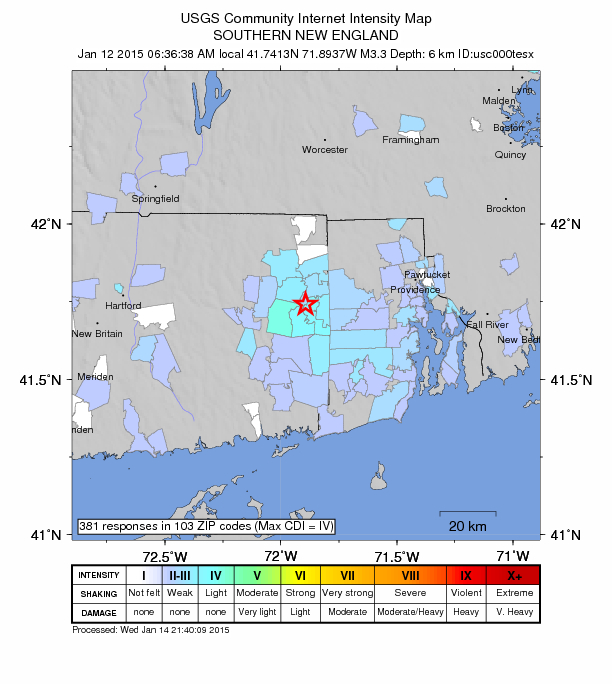What's with all the earthquakes in Connecticut?
Connecticut is not known as a hotbed of seismic activity, but residents in and around Plainfield, in the eastern part of the state, have felt tremors more than a half dozen times in the past few days.
The first reports came in Thursday morning, Jan. 8 -- a 2.0 magnitude earthquake centered near Danielson, about 10 miles from Plainfield, near the Rhode Island border. By some accounts, as many as nine more quakes, one reaching as high as 3.3, were reported over the next six days, including six on Monday and one early Wednesday. The cluster of quakes, all close together both in time and in place, is what scientists call a "swarm."
Yet another quake hit Plainfield early Thursday -- this one a 2.2 magnitude temblor.
"Moderate to large earthquakes are rare in New England, but as we have seen over the past week, Connecticut is not immune to earthquake activity," Connecticut Department of Emergency Services and Public Protection commissioner Dora B. Schriro said in a statement Wednesday. "These small quakes have not and typically do not result in injuries or significant damage to property, but we want to assure everyone that we continue to work with all of our public safety partners to mitigate any potential issues that may arise."
"This is fairly unusual," said Maureen Long, an assistant professor in the geology department at Yale University. "It's definitely been an interesting week for us."
Long said that swarms are not unprecedented in Connecticut -- one in the 1980s in the village of Moodus, farther west in the state, comprised hundreds of small quakes -- but they are very rare.
Connecticut is located in the middle of a tectonic plate, far from a boundary where the movement of two plates can cause strong and frequent quakes, like in California. But the geology of the state is actually quite complex, owing to lots of tectonic activity in its prehistoric past.
Plainfield is not far from an ancient fault called the Lake Char-Honey Hill line that formed when the Pangea supercontinent was assembled about 400 million years ago. Like most faults in Connecticut, it is not thought to be active, but some of these old faults can build up stresses that lead to structural failures that cause earthquakes.
"The hypothesis is that you're getting the release of stress when these ancient faults are breaking," Long told CBS News. But scientists can't be sure that the fault, which lies about 5 km (about 3 miles) underground, was responsible for the tremors. "If you look at a geological map of eastern Connecticut, there are a lot of faults and there may well be faults we don't know about because they don't extend to the surface. It's hard to associate a particular earthquake with a particular fault when it's far away. But it's certainly reasonable."
It's similarly challenging to say what might have precipitated a quake, especially in a location that is far from the tectonic shifts that usually cause seismic activity. In states such as Oklahoma, fracking has triggered seismicity, but Long said that's not the case here. "In Connecticut we don't have the right geology for natural gas, so there is no fracking. These is no evidence that this is anything other than a natural process."
One theory points to glaciers which covered the Northeast tens of thousands of years ago. The weight of the massive volume of ice pressed down into the earth, and like a memory foam mattress regaining its shape, the land might still be working its way back into place. This process, called glacial rebound, could be the source of the stress that has caused the quakes.
The downside of being in a region that doesn't get a lot of earthquakes is that there is a dearth of data to help predict activity. It's a challenge for scientists to forecast when a quake might come in southern California; it's even harder in Connecticut.
"It's impossible to predict how long this swarm will last. It's within the realm of possibility that it will last weeks, or months, or end tomorrow," said Long.
For residents who lived near enough to the epicenters to have heard the boom or felt the trembling of the earthquakes, it might be wise to stay vigilant -- and take any valuable glassware off the top shelf.
For its part, the town of Plainfield plans to hold an informational meeting about earthquakes in the Plainfield High School auditorium Friday evening.

